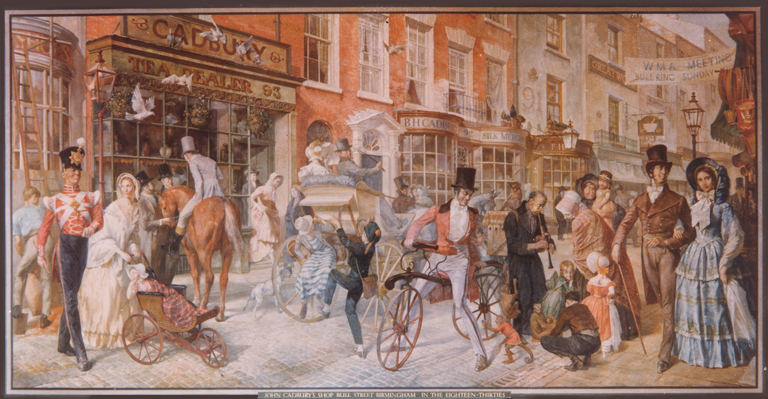
Cadbury’s Tea Shoppe
I caught a couple episodes the other night of The Foods That Built America and was hooked. So it got me wondering about household food related names that got their start in the Regency.
My first find was John Cadbury. Yep, that Cadbury.
Here’s a little about him. Born in 1801 in Birmingham, John Cadbury was from a wealthy Quaker family. John apprenticed himself to a Leeds tea dealer in 1816 (John Cadbury (quakersintheworld.org)). That inspired him to start up a grocer’s shop in Birmingham, with financing from her draper father, in 1824 where he sold tea, coffee and drinking chocolate (History and About Us | Cadbury Chocolate (cadburyusa.com).
The shop distinguished itself, attracting curious customers, through unusual windows, a Chinese clerk and Asian influenced decor, and the “nutritious breakfast” beverage John prepared from cocoa nibs with a mortar and pestle (John Cadbury (quakersintheworld.org)). His shop would catch the interest and patronage of many prominent families, including the Lloyds banking family.
Quakers promoted drinking chocolate as an alternative to booze, and John decided it was a sound business so opened a warehouse to begin commercial manufacture. The four storey warehouse in Crooked Lane supported expansion of his enterprise (The Cadbury Family | Sky HISTORY TV Channel). By 1842, he sold 16 lines of drinking chocolate and eleven lines of cocoa.
By 1847, John and his brother Benjamin have established the Cadbury Brothers and opened a new factory that is larger, more central, and served directly by a canal (The Cadbury Family | Sky HISTORY TV Channel). With a tax cut on the import of cocoa, business booms even more and by 1854 Queen Victoria gave them their first Royal Warrant.
Birmingham History and General Directory of the Borough of Birmingham, with the Remainder of the Parish of Aston (1849)
The rest, as they say, is history. But mostly, that history is John passing off the business to his two sons who make the company what it is today (The Cadbury Family | Sky HISTORY TV Channel).
Cadbury was more than a business mogul, however, being devoted to the temperance movement and animal rights (Winskill, 1893). He formed the Birmingham Temperance Society and the Animals Friend Society, which would evolve into the Royal Society for the Prevention of Cruelty to Animals.
The son’s Cadbury factory would feature the garden village of Bournville, which they developed as an idyllic, dry district which is still dry to this day.
John suffered from depression and would later contract rheumatic fever, so that retirement was a necessity. He died in 1889.
Winskill, p. (1893) The Temperance Movement and Its Workers. Retrieved: https://books.google.com/books?id=MIHaAAAAMAAJ&pg=PA116&dq=cadbury&hl=en&newbks=1&newbks_redir=1&sa=X&ved=2ahUKEwiroKuSzqvyAhXYrJ4KHdVCBJkQ6AEwCHoECAkQAg











